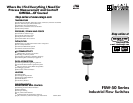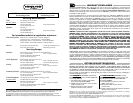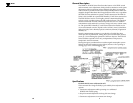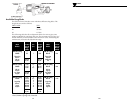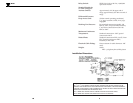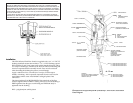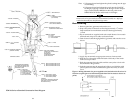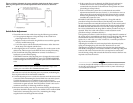
6 7
All FSW-50 Series Switches are factory set at the lower end of the flow range, i.e., the
adjusting screw is set at the low flow COUNTERCLOCKWISE position.
NOTE
Figure 2: Wiring Schematic for power applied to load when the flow is greater
than set point (power to load interrupted when flow decreases to below set
point).
Switch Point Adjustment
1. Thread the unit into line while observing the following precautions:
a) Use appropriate adapters to keep the body of the switch from
projecting into the flow stream.
b) Inspect to make sure that the drag disk does not touch the opposite
wall of a small diameter pipe.
c) Use Teflon tape to seal the threads and lubricate to allow the arrow
on the body to be aligned with the flow.
2. After aligning the arrow with flow, adjust the flow in the system to the
desired rate without regard to the FSW-50 Series switch point setting.
3. The Switch Point Adjusting Mechanism consists of a leadscrew, a
leadscrew nut and a helical spring.
CLOCKWISE rotation of the adjusting screw changes the microswitch
actuation point toward HIGHER flow rates. COUNTERCLOCKWISE
rotation changes the microswitch actuation point toward LOWER flow
rates.
The leadscrew nut locks the adjusting screw in position, maintaining the
flow set point under all environmental conditions.
4. Turn the adjusting screw in a clockwise direction until the microswitch
is actuated while maintaining the desired fluid flow rate in the system.
Turn the adjusting screw two additional turns in the clockwise
direction and then slowly back off in a counterclockwise direction until
microswitch is again actuated. The FSW-50 Flow Switch is now set for
maximum sensitivity for detecting small flow changes.
5. Microswitch actuation point may be monitored during the adjustment
procedure detailed in Step 4 above by an audible click or with an OHM
meter before connecting line power or by monitoring the voltage
supplied to the load through the microswitch.
6. If the system flow rate is changed, the FSW-50 can be adjusted to
monitor the new flow rate by turning the adjusting screw in a
counterclockwise direction to the minimum flow position and then
proceeding as in Step 4 above.
7. In the event that the system flow is at the desired rate and the
adjustment mechanism runs out of travel, i.e., the leadscrew nut is at
either end of the support bracket before the microswitch is actuated,
then the drag disk must be changed to shift the flow range so that it
straddles the system flow rate.
EXAMPLE: If the FSW-50 is fitted with a No. 1 drag disk and the
procedure in Step 4 has been followed, the adjusting screw has been
turned counterclockwise until the leadscrew nut is at the extreme end of
the support bracket (spring fully relaxed) and the microswitch still has
not been actuated, then the flow is too low and a larger drag disk will
have to be substituted for the drag disk #1 and the procedure in Step 4
repeated. If the No. 2 disk will not allow switch actuation via the
procedure in Step 4, substitute disk No. 3.
The opposite procedure is used if the flow is so high that full extension of
the spring cannot counterbalance the fluid forces on the drag disk and the
switch remains actuated. Proceed by using a smaller drag disk, e.g.,
replace No. 3 with a No. 2, or a No. 2 with a No. 1 until the procedure in
Step 4 can be accomplished.
Adjusting the moment arm can be employed after adjustment by the
spring and changing drag disk sizes have been tried to no avail.
Adjusting the moment arm consists of moving the drag disk along the
arm thereby changing the force-balance moment arm. Moving a drag disk
to the far end of the arm lowers the flow rate required to activate the
switch. Moving a drag disk towards the filter boot increases the flow rate
required to activate the switch.
It is necessary throughout all installation and adjustment procedures to check to ensure that
the drag disk is perpendicular to the flow and does not touch any interior surface through-
out its complete fore and aft travel.
NOTE



